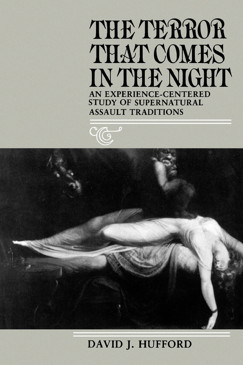Review: The Terror That Comes in the Night June 4, 2013
Author: Beach Combing | in : Contemporary, Medieval, Modern , trackbackBeach has been lucky with his reading recently. It began with Dennis Gaffen’s Running with the Fairies, passed on to Chris Woodyard’s Face in the Window and Emma Wilby’s Cunning Folk and then there was a jump back in time with Mike Dash’s Borderlands. Another excellent addition to his library has been David J.Hufford’s The Terror That Comes in the Night: An Experience-Centred Study of Supernatural Assault Traditions, first published in 1982 by Pennsylvania Univ Press. In this book DH basically sets himself a problem. In the folklore of Newfoundland there is a tradition termed the Old Hag, the belief that an ‘enemy’ (let’s keep things generic) can send a ‘hag’ to attack you in your sleep. DH began to study the Old Hag when, as so often happens with research, things span out of control. He realized that experiences typical of the Old Hag – sleep paralysis, a malevolent presence (terrifying amorphous faces looming over sleepers), the sensation of someone pressing on your chest – were also found in those who’d never even heard of the Old Hag. He then took his campaign to the mainland and the US appearing in lectures and radio shows. Listeners, then, got in touch to describe their own experiences of similar phenomenon and his corpus of Old Hag material (though by then this Nuffie term was looking rather provincial) grew and grew.
The book is fascinating for several reasons. First, here we have a folklore scholar who has had to deal with real life experiences, rather than half remembered tales or urban legends. His methodology is not borrowed because there was nothing really suitable hanging from the tree. Rather he created his own interviewing system to deal with this unusual circumstance. In fact, this book might stand as a paradigm for any small ‘s’ skeptical Fortean investigator out there looking at unexplained phenomenon: say, fairy or alien sightings.
Second, it is striking how a physiological fact, one that has not incidentally been properly understood by the medical profession, can insert itself into a series of unexplained phenomenon. There is one very dense and very difficult to understand poltergeist case described in this book (chapter five), in which ‘the hag’ seems to have played a central or an embroidering role. It is perhaps the single most fascinating and yet the single most bewildering thing in a book with lots of surprises.
Third, the book highlights the way that psychologists, largely failed to grasp the independent existence of ‘the Hag’ as a phenomenon. A series of different sleep disturbances ranging from the Hag to bad dreams were lumped, unscientifically, together. It is ironic that it took a folklorist to actually sort through the data and create a proper category: but that is what happen when you listen to people, instead of analyzing everything in terms of unresolved father-centred angst etc etc (aka Freudian voodoism).
Just a final thought. If you had lived in Newfoundland, c. 1900 and you had suffered from sleep paralysis you would at least have had a name for this ‘thing’ that was happening to you. Your family would have sympathized and there would have been an attempt to winkle out the ill-wisher who had caused this pain. There were also rituals, invitations to placebo. However, if you lived in Pittsburgh in 1970, you are in a folklore wilderness, and there is no name for this thing, which science has conspicuously failed to label. Your experiences get you sent to doctors, who send you to psychologists and your family worry about your mental health. You are in a very lonely place, and a basic human malfunction (or just possibly function) becomes a critical problem. As DH spoke to people about the Old Hag he found himself (reluctantly) being put in the role of a therapist. He was talking to individuals who had been isolated and he was able to tell them that the experiences that they had had were abnormal but not unprecedented or dangerous.
Beach is always on the look out for good books: drbeachcombing AT yahoo DOT com
30 June 2013: Wade writes in: There is a lot of discussion among the UFO crowd, both believers and skeptics, about whether the Old Hag phenomena is the source for the majority of alien abduction claims. Sleep paralysis is terrifying. I experienced it one time years ago and I wouldn’t want it to happen again. Then EC with an honest to God experience: Not sure if this is the sort of response you’re looking for on this one, but I experienced “The Hag” when I was seventeen years old. My sister did as well. The experience was indeed terrifying: I *knew* that the (what I later came to call) “thought clusters” that were menacing me were definitely not within my mind – it’s hard to describe but they did not have the “flavor” that all my imaginings have, a “flavor” that I only realized existed when this thing from “outside” appeared and lacked it. And yes I felt paralyzed and also that I was partially leaving my body. Even knowing as I do now that the phenomenon of night terrors is common, and being generally sceptical, has not removed the secret suspicion that I was once threatened by a malevolent nonhuman intelligence.’ Thanks EC and Wade!



